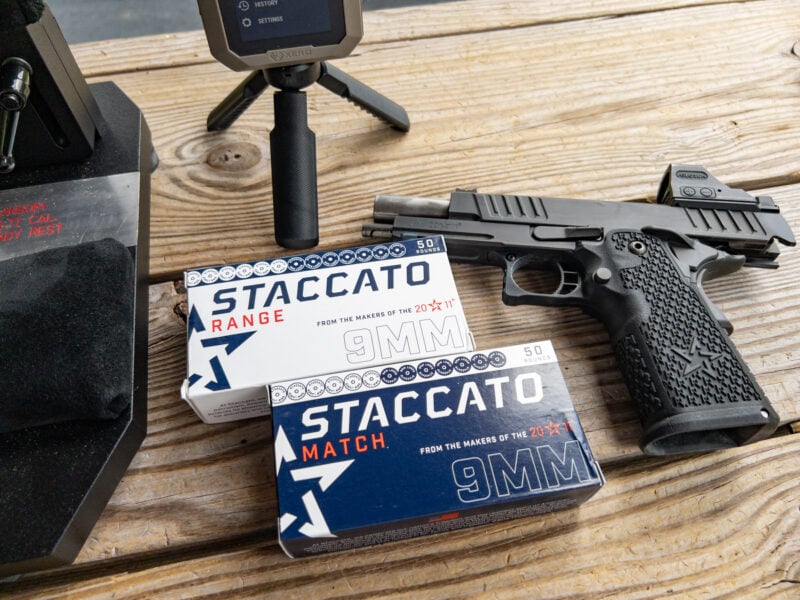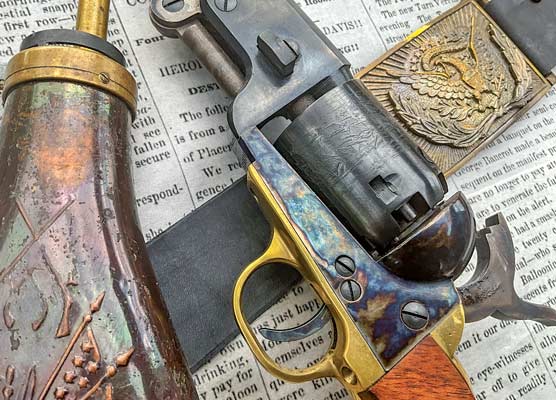Ammo Testing:
Staccato Range and Match 9mm
I think you have to exercise some care when testing ammo. Sure, you can load it up, aim at targets downrange, and fire away. Pretty much all modern ammo does an adequate job of going bang every time and firing in the forward direction. I suppose that’s a good thing. A century or so back, in the age of weird systems like pinfire cartridges, wads, grease, and bashing stones together to fire each shot, things weren’t nearly so predictable.
Modern Ammo
Here’s the thing. Modern ammo, especially the premium stuff, is generally so good out of the box you have to implement some rigorous testing rules to really see what it can do. I mean, thinking back over the past couple of years, while I’ve had some jams here and there (might be the gun, might be the ammo, or a combination of both), I can’t remember a single failure to ignite or squib load from a reputable factory round. Several years back, I had a couple; those tracked back to a single lot of bad primers that made their way into one specific lot of major manufacturer premium ammunition. Other than that, it just works with boring regularity. That’s a good thing.
The point is, with modern manufacturing systems and some truly incredible automated inspection technology, cartridges that roll off the line are just going to work as expected. Lasers, scales, and other custom equipment at each step in the process inspect the most minute details like primer depth, charge, bullet seating, and, of course, precise shape and dimensions of every component.
Testing
Testing modern ammo requires some careful planning, as much of it is capable of better performance than an unassisted shooter. I like to remove as many shooter-related variables as possible. If I stand there and fire freehand from 25 yards, that’ll tell you something about my eyesight, whether I have steady hands, and my trigger press, but it certainly won’t shed any meaningful light on the “mechanical” performance of the ammo itself. To do that, we need to eliminate as many variables as possible.
I always shoot strings over a good chronograph when testing new ammo. I don’t really care whether it exits the muzzle of my test gun at 1,150 or 1,173 feet per second (fps). What I do care about is the shot-to-shot consistency of velocity. Over ten (or more) shots, what is the extreme spread between the lowest and highest velocity readings? For example, if my lowest reading is 1,050 fps and my highest for a given type of ammo is 1,195, then the extreme spread is 145 fps. That’s a lot of accuracy-robbing velocity variance. Extreme spread also sheds a clue as to whether the ammo is not manufactured consistently round to round. Lately, I’ve been working with a Garmin Xero C1 Pro, and it does a wonderful job of consistently capturing velocity data.
For accuracy testing, I always use a good rest (in my case, the Ransom Multi-Caliber Steady Rest) and almost always test at 25 yards with five-shot groups. To eliminate eyesight and associated tiny sight alignment errors, I try to use either a quality red dot with a one MOA dot or a handgun scope, depending on what mounting options I can cobble together. Either one of those does a marvelous job of virtually eliminating sighting error variability.
Staccato’s New Ammo
At SHOT Show, I had a conversation with the folks from Staccato 2011 about their new lines of 9mm Range and Match ammo.
The Range series uses a 124-grain FMJ projectile and is rated at 1,030 fps. Of course, that velocity will vary with the barrel length of your gun. It uses (reloadable if you care) brass cases. When I tested it using a Staccato P pistol with a 4.4″ barrel, I measured an average velocity of 1,131.2 fps, so I assume the factory specs are for a more compact pistol. The extreme spread was just 29.3 fps—that’s really consistent.
As for accuracy, the company claims it’ll shoot 2″ or less groups and sure enough, I confirmed that with ease. The first three five-shot groups I fired from 25 yards averaged just 1.77″ center-to-center. As the name implies, the Range Series is targeted at affordable plinking and practice, and judging by my results, it’ll do just fine in competition, too. As you’d expect, it’s more affordable than the match variant, retail priced at $19.95 per box of 50. Buying by the case will save you another nickel per round.
The Match variety uses the 125-grain Hornady HAP projectile, designed for accurate performance with its slightly larger diameter. It’s still reasonably priced considering its performance, coming in at a retail of $24.95 per 50-round box. Again, you’ll save a nickel a round buying by the case.
As if the Range version doesn’t perform, the Match stuns. It’s rated at 1,050 fps, and the company promises 1″ or smaller groups when shooting from Staccato pistols. I measured the average velocity with the Garmin of 1,077.9 fps with an extreme spread of 32.2 fps. As for accuracy? Yet again, the Staccato Match didn’t disappoint relative to its claims. My first three five-shot groups from 25 yards averaged 0.93″, with the best group coming in at just 0.76″. That’s stunning.
—
Get more exclusive online content delivered straight to your inbox. Sign up for our free American Handgunner Insider newsletter.





